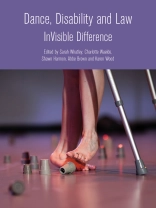This collection is the first book to focus on the intersection of dance, disability, and the law. Bringing together a range of writers from different disciplines, it considers the question of how we value, validate, and speak about diversity in performance practice, with a specific focus on the experience of differently-abled dance artists within the changing world of the arts in the United Kingdom. Contributors address the legal frameworks that support or inhibit the work of disabled dancers and explore factors that affect their full participation, including those related to policy, arts funding, dance criticism, and audience reception.
Зміст
Preface
Sita Popat
Introduction
Sarah Whatley, Charlotte Waelde, Shawn Harmon, Abbe Brown, Karen Wood, Kate Marsh and Mathilde Pavis
Section I: Disability, Dance and Critical Frameworks
Chapter 1: Disabled Dance: Barriers to Proper Inclusion within Our Cultural Milieu
Shawn Harmon, Charlotte Waelde and Sarah Whatley
Chapter 2: Cultural Heritage and the Unseen Community
Fiona Macmillan
Chapter 3: An Analysis of Reporting and Monitoring in Relation to the United Nations Convention on the Rights of Persons with Disabilities, the Right to Participation in Cultural Life and Intellectual Property
Catherine Easton
Chapter 4: A Dance of Difference: The Tripartite Model of Disability and the Cultural Heritage of Dance
David Bolt and Heidi Mapley
Chapter 5: In a Different Light? Broadening the Bioethics Perspective through Dance
Shawn Harmon
Section II: Disability, Dance and the Demands of a New Aesthetic
Chapter 6: A Wondering (in Three Parts)
Luke Pell
Chapter 7: A New Foundation: Physical Integrity, Disabled Dance and Cultural Heritage
Abbe Brown, Shawn Harmon, Kate Marsh, Mathilde Pavis, Charlotte Waelde, Sarah Whatley and Karen Wood
Chapter 8: Disability and Dance: The Disabled Sublime or Joyful Encounters?
Janice Richardson
Chapter 9: Moving Towards a New Aesthetic: Dance and Disability
Shawn Harmon, Kate Marsh, Sarah Whatley and Karen Wood
Chapter 10: What We Can Do with Choreography, and What Choreography Can Do with Us
A conversation between Catherine Long and Nicola Conibere
Chapter 11: Dancing Identity: The Journey from Freak to Hero and Beyond
Eimir Mc Grath
Chapter 12: Dance Disability and Aesthetics: A Changing Discourse
Margaret Ames
Section III: Disability, Dance and Audience Engagement
Chapter 13: The (Disabled) Artist Is Present
Claire Cunningham
Chapter 14: Disability, Disabled Dance Audiences and the Dilemma of Neuroaesthetic Approaches to Perception and Interpretation
Bree Hadley
Chapter 15: Finding It When You Get There
Adam Benjamin
Про автора
Dr Hetty Blades is Assistant Professor in the Centre for Dance Research (C-Da RE) at Coventry University. Her research considers philosophical questions posed by the making and transmission of dance works and practices. Recent edited books include, Performing Process: Sharing Dance and Choreographic Practices with Emma Meehan (2018, Intellect) and Dance, Disability and Law: In Visible Difference with Sarah Whatley, Charlotte Waelde, Shawn Harmon, Abbe Brown and Karen Wood (2018, Intellect). She worked as an Research Assistant on Resilience and Inclusion: Dancers as Agents of Change (AHRC) and was Co-Investigator on Performing Empowerment: Disability, Dance and Inclusive Development in Post-War Sri Lanka (AHRC/ESRC). She is currently Co-I on Performing Inclusion (British Council Sri Lanka).












